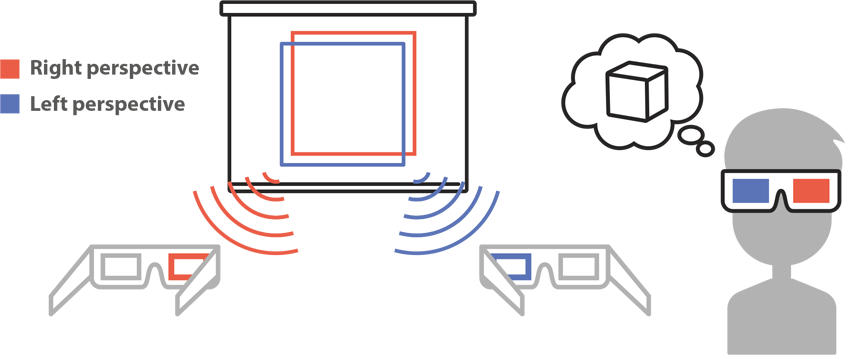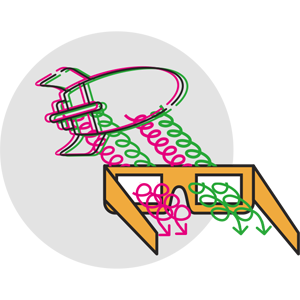Product request
You are looking for a solution:
Select an option, and we will develop the best offer
for you
An Insight into 3D

Years have passed since 3D first became available on TVs, and the debate is still on: is it a real technological step forwards for entertainment and viewer experience or is it just a trick? An important point that is rarely considered is the fact that 3D is not a single technology, but several different ones with different methods, each having their own pros, cons and areas of application.
How it works
Nearly every single modern method for creating three-dimensional images is based on the physiological features of the human eye. The human eyes are positioned 60-70 mm away from each other, which enables us to see the world from two different positions simultaneously. Therefore, the right and left eyes capture images of the same object but at different angles.
The images that the eye captures are called stereopair. When our brain analyses the difference between the images received by the right and left eye, it deduces how far away the observed object is.
In order to create the 3D effect in cinema, the principle of separate viewing is applied: each eye is shown an image that is intended only for that eye. This separation can occur in various ways, each way having its pros and cons.
Anaglyph
Otherwise known as ‘classic 3D’, Anaglyph technology is over a hundred years old. It is based on the biological structure of the human eye. There exist three types of photosensitive receptors on our retinas. Only one of the primary colours are perceived by each type: blue, red, green.
In order to achieve the illusion of depth, the image is divided into two channels. Such as, red and turquoise which is a mix of blue and green. The subsequent layers are then superimposed with a slight shift. By wearing glasses with lenses of the same colours, the viewer receives a separate monochrome image for each eye.
The downside to this method is an incomplete colour rendering. The image is perceived as being achromatic or single-tone. The viewer is quickly accustomed to the effect. Nevertheless, upon taking off the glasses and seeing the real world as opposed to a red-blue one, the viewer can experience extreme discomfort.

Anaglyph 3D, in its classic form is practically never used. However, its successor, the super-anaglyph, is often used in Dolby 3D technology. In super-anaglyph 3D, the classic single-tone lenses are replaced by special interference filters, which reduce the distortion of colours to some degree. Yet, despite that, this particular technology continues to lose its backers.

Interlaced method
In this method, an image for one eye is recorded in even, interlacing lines, and then for the other eye it is recorded in odd lines. The end result is a full-colour image with a ‘comb’ effect. The three-dimensional illusion is achieved by merging images using deinterlacing, a technology that creates a single frame from two half-frames of the interlaced format for output to monitors with non-interlaced scanning.
The image’s colour rendering is retained completely, while the vertical resolution is cut in half.
This particular method is rare. It was formerly used to make 3D DVD discs. Nowadays, with a passive separation of camera angles in 3D monitors, this method is experiencing a new wave of popularity. Even lines are passed through one type of polarisation, while odd lines pass through another type. The only thing you need for viewing is polaroid glasses.

Eclipse Method
The eclipse method consists of images being shown in an alternating way, and being intended for the left or right eye. All the while, the lenses of the glasses worn by the viewer are darkened synchronously in order that each eye sees only the image intended for it.
The frames change at a very high frequency that is over 120 Hz. What is known as the persistence effect, the brain’s ability to combine frequently changing static frames into a moving image, causes the viewer to think that they are seeing a qualitative three-dimensional image.
This particular method was established in the Teleview system in 1922. People were offered the opportunity to watch movies through a special mechanical shutter.

Over time and thanks to the development of new technologies, the mechanical shutter was replaced by liquid crystal shutter glasses, although the operating principle remained the same. All of this technology’s advantages can be seen when using XpanD and nVidia 3D Vision technologies.

Polarisation systems
The Polarisation method’s particular nature is to superimpose frames with different light polarisations: the ‘right’ frame has horizontal polarisation, while the ‘left’ frame has vertical polarisation.
The lenses of the glasses serve as filters that let pass images of the corresponding polarisation. In this way, the right eye can only see the ‘right’ frames, and the left eye can only see the ‘left’ frames.

The means of viewing is dependant on the type of polarised glasses:
 | Circular polarised glasses have built in them special analysis filters which enable viewers to see an entire three-dimensional image from any position. MasterImage 3D, RealD Cinema, and Volfoni Smart Crystal technologies are based on the polarisation principle. |
 | Linear polarised glasses require the user to keep their head at the same level. If the filters are tilted or rotated in any way, they stop transmitting light and the 3D effect is lost. This method is used notably in IMAX 3D cinemas. |
Polarisation enables the viewer to see a full-colour image with maximum resolution, unlike previous methods. Nonetheless, polarisation technology’s costs are significant. A special silver coated screen is required for a quality display with preservation of polarisation. The brightness of the image also needs to be increased, since polarisation filters absorb up to 70% of light.

Depth and solidity without glasses
Glasses are not always required for 3D. There are many other technologies that enable viewers to watch three-dimensional images without the need for additional accessories. This method is called autostereoscopy.
For this, the image is divided into narrow vertical strips that alternate for the left and right eyes. There is a raster in front of the screen that hides from each eye the images that are not intended for it. When at a sufficient distance from the screen, the strips merge into a single halftone image.
The most common types of raster are:
- A lenticular lens is an assembly of plano convex cylindrical lenses. The lenses enable the light to be refracted from the screen in such a way that each eye sees only the correct part of the image. Stereo postcards also use the same principle.
- A parallax barrier comprises of vertical opaque strips, with thin slits in between them.
Autostereoscopy is quite uncommon in cinematography, but it is widely used in game consoles and smartphones.

Even though the debate is still ongoing, 3D video playback technology continues to grow and evolve. Companies provide new solutions and improve on the old ones. Which 3D technology will become the next market leader? Will 3D TV just be fazed out? What do you think?
Recommended

What to Consider When Scaling an IPTV Service to New Regions
Scaling an IPTV service to new regions is not just about content delivery optimization, but a task that requires a careful approach and deep analysis of several factors.

How to Choose the Best IPTV Content Aggregator
The interactive television market continues to grow dynamically, and, along with the technical base, functional IPTV platform and high-quality analytics, one of the key factors for the operator’s success is the correct selection of content.

Launching an IPTV Service in a Small City: Key Challenges and Solutions
Launching IPTV in a small community is often seen as a challenging but potentially very lucrative project.










